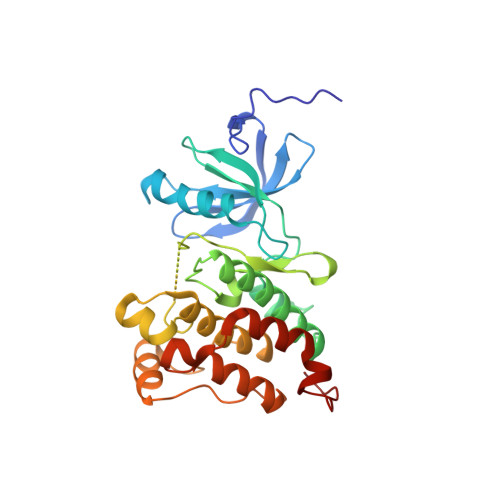Comparative analysis of mutant tyrosine kinase chemical rescue.
Muratore, K.E., Seeliger, M.A., Wang, Z., Fomina, D., Neiswinger, J., Havranek, J.J., Baker, D., Kuriyan, J., Cole, P.A.(2009) Biochemistry 48: 3378-3386
- PubMed: 19260709
- DOI: https://doi.org/10.1021/bi900057g
- Primary Citation of Related Structures:
3GEQ - PubMed Abstract:
Protein tyrosine kinases are critical cell signaling enzymes. These enzymes have a highly conserved Arg residue in their catalytic loop which is present two residues or four residues downstream from an absolutely conserved Asp catalytic base. Prior studies on protein tyrosine kinases Csk and Src revealed the potential for chemical rescue of catalytically deficient mutant kinases (Arg to Ala mutations) by small diamino compounds, particularly imidazole; however, the potency and efficiency of rescue was greater for Src. This current study further examines the structural and kinetic basis of rescue for mutant Src as compared to mutant Abl tyrosine kinase. An X-ray crystal structure of R388A Src revealed the surprising finding that a histidine residue of the N-terminus of a symmetry-related kinase inserts into the active site of the adjacent Src and mimics the hydrogen-bonding pattern seen in wild-type protein tyrosine kinases. Abl R367A shows potent and efficient rescue more comparable to Src, even though its catalytic loop is more like that of Csk. Various enzyme redesigns of the active sites indicate that the degree and specificity of rescue are somewhat flexible, but the overall properties of the enzymes and rescue agents play an overarching role. The newly discovered rescue agent 2-aminoimidazole is about as efficient as imidazole in rescuing R/A Src and Abl. Rate vs pH studies with these imidazole analogues suggest that the protonated imidazolium is the preferred form for chemical rescue, consistent with structural models. The efficient rescue seen with mutant Abl points to the potential of this approach to be used effectively to analyze Abl phosphorylation pathways in cells.
Organizational Affiliation:
Department of Pharmacology and Molecular Sciences, Johns Hopkins University School of Medicine, Baltimore, Maryland 21205, USA.















